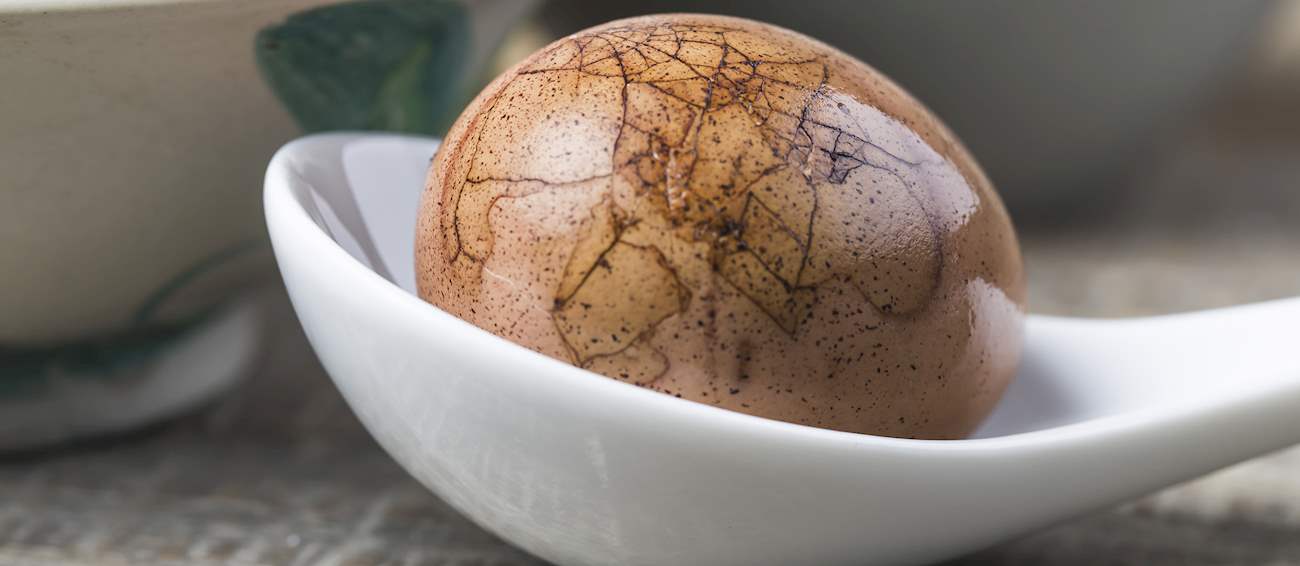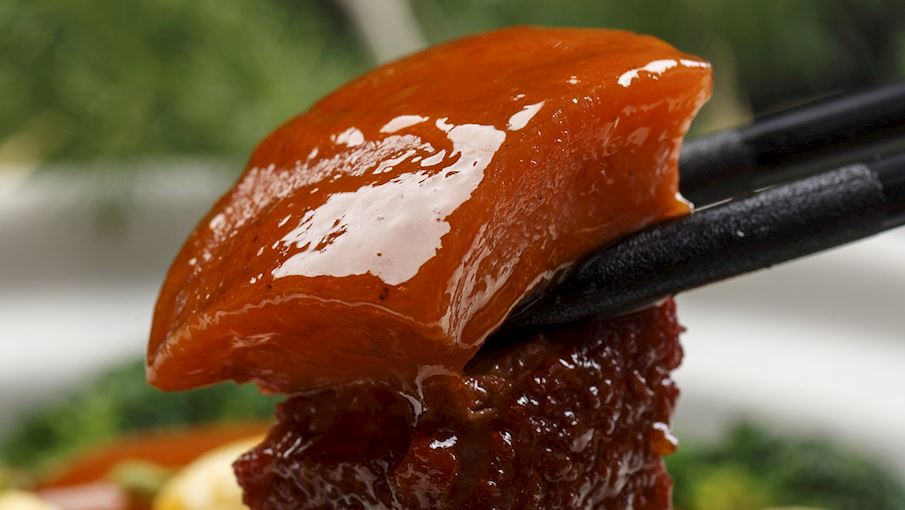MAIN INGREDIENTS
The traditional Hangzhou's trademark dish of red-cooked pork belly, Dōngpō ròu, is built with a handful of Chinese staple ingredients like ginger, scallions, soy sauce and, most importantly, Shàoxīng rice cooking wine, an essential ingredient for red-cooked meals.
The meat (with the skin on) is typically browned in fat, simmered twice, braised, sautéed, and finally steamed, after which it becomes so amazingly tender it can be pulled away with chopsticks. Dōngpō ròu is said to have been invented (or at least inspired) by Su Dongpo, an 11th-century Song Dynasty statesman, poet, artist, calligrapher, and one of the four classical Chinese gastronomes.
MAIN INGREDIENTS
Despite its unusual name, tea is not the dominant flavor in tea egg, a popular, traditional snack item that originated in Zhejiang, but is found throughout China. The snack consists of an egg that is hard-boiled in (usually black) tea, soy sauce, and numerous spices such as anise, cinnamon, cloves, fennel, and peppercorns, which add a savory, slightly salty note to a normal egg.
Tea egg is usually sold by street vendors, but it can also be found in numerous Chinese markets and Asian restaurants. It is commonly consumed on its own or served with accompaniments such as noodles or rice. Traditionally, tea eggs are eaten during Chinese New Year, symbolizing wealth, prosperity, and fertility.
Jinhua is a traditional type of dry-cured ham originating from the city of Jinhua in the Zhejiang province. The ham is produced using the hind legs of native Chinese pig breeds that have great meat and thin skin. Many procedures are necessary to produce this salty and tough ham, such as dressing, trimming, salting, washing, drying, fermenting, and smelling.
The ham leg is cleaned, dressed, and salted six times, about a month between each salting. It is then stored in cool and dark place from six to eight months in order to develop the distinct flavor and aroma. Jinhua ham is typically used as a flavoring for stews and braised dishes, as well as making broths and stocks for Chinese soups.
MAIN INGREDIENTS
Fried eel slices is a Chinese dish that is especially popular in Hangzhou. It consists of eel slices that are stir-fried with garlic, creating a unique flavor in the process. These eel slices have a sour and sweet flavor and they are crisp on the outside while remaining tender inside.
In recent years, Hangzhou cooks developed a new method of preparing the dish – the eel slices are deep-fried until partially cooked, and they are then braised to achieve a soft "skin".
MAIN INGREDIENTS
Regarded as a specialty of Hangzhou city, fried shrimps with Longjing tea is one of the best-known dishes of Zheijang cuisine that makes use of the outstanding Longjing tea. Large live shrimps are first soaked in a marinade of egg whites, cornstarch, and rice wine, and then cooked along with steeped Longjing tea.
The fragrant and refreshing green shoots of Longjing tea beautifully complement the delicious white shrimps, giving this authentic dish an exquisite flavor. These stir-fried shrimps are served hot or chilled, drizzled with the cooking liquid and seasoned with salt and pepper to taste.
MAIN INGREDIENTS
Hangzhou-style duck pickled in soy sauce is a delectable specialty dish of Hangzhou cuisine that delivers the authentic flavors of the region. This dish consists of duck meat cooked in a marinade, and it is then covered with soy sauce and served alongside rice or noodles.
Deliciously crispy on the outside while remaining tender and moist on the inside, the duck is commonly served chilled. This dish is aromatic, predominantly savory, and slightly sweet in flavor. It is traditionally prepared and consumed during the celebration of the Chinese Lunar New Year.
MAIN INGREDIENTS
Fried rice with bean sprouts is a traditional dish that's especially popular in Hangzhou. The dish is usually made with a combination of cooked rice, scallions, diced Jinhua ham, soy sauce, bean sprouts, oyster sauce, vegetable oil, and black pepper.
The scallions are fried in a wok until soft, and then mixed with the ham, stir-fried, and mixed with the cooked and chilled rice. The oyster sauce, soy sauce, and pepper are added to the wok, the mixture is stir-fried a bit more, and the bean sprouts are added in the final few minutes of cooking.
MAIN INGREDIENTS
The Chinese dish known as braised spring bamboo shoots is often seen in the menus of numerous restaurants in the country because it is easy to prepare, high in nutrients, and has a delicious, savory flavor. Spring bamboo shoots are unearthed around April 5, also known as the Tomb-Sweeping Day.
In order to prepare the dish, tender bamboo shoots are simply braised in vinegar and lots of sugar. When properly prepared, the dish should have a bright red color and a flavor which can best be described as tender, fresh, salty, and sweet.
Beggar's chicken is a Chinese delicacy and the city of Hangzhou's most famous dish, consisting of only one ingredient - a whole chicken. The secret is in the preparation method: the stuffed chicken is tightly wrapped in lotus leaves, packed in clay, and baked in a special oven or over an open fire, resulting in tender, moist, and aromatic meat, along with being one of the visually most interesting dishes in existence.
Once the dish has been served, the hard outer shell is often cracked open with a hammer. Legend has it that a starving beggar was in possession of a chicken but had no means to prepare it, so in a stroke of genius, he covered it with mud and baked it over an open fire.
MAIN INGREDIENTS
A dim-sum classic, fried stuffed bean curd paste is an exceptionally delicious and nutritious Chinese dish. This dish enhances the otherwise subtle flavor of bean curd by stuffing hollow bean curd pieces with a prawn-and-pork mince filling. The stuffed bean curd pieces are then pan-fried until nicely browned and crispy on the outside.
Typically garnished with chopped scallions or coriander, the dish is often served with a dipping sauce made with chicken stock, oyster sauce, Shaoxing rice wine, and sesame oil.
OTHER VARIATIONS OF Dim sum
TasteAtlas food rankings are based on the ratings of the TasteAtlas audience, with a series of mechanisms that recognize real users and that ignore bot, nationalist or local patriotic ratings, and give additional value to the ratings of users that the system recognizes as knowledgeable. TasteAtlas Rankings should not be seen as the final global conclusion about food. Their purpose is to promote excellent local foods, instill pride in traditional dishes, and arouse curiosity about dishes you haven’t tried.













